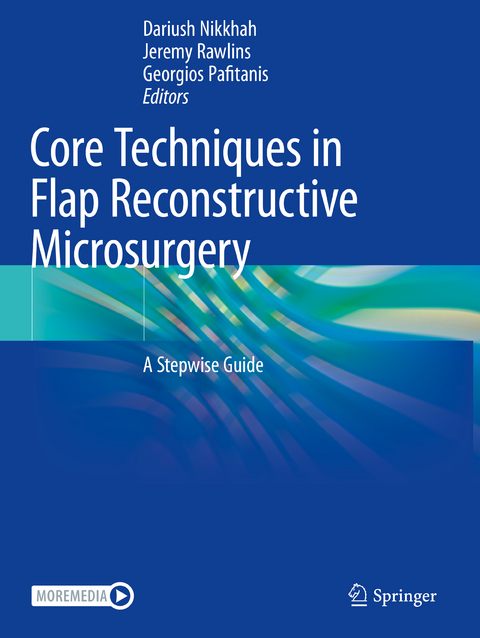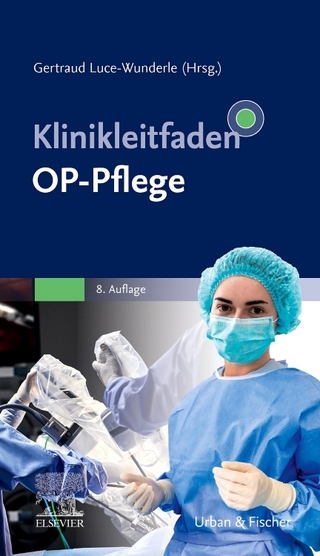
Core Techniques in Flap Reconstructive Microsurgery
Springer International Publishing (Verlag)
978-3-031-07680-0 (ISBN)
This book provides a practical, step-by-step guidance on modern workhorse flaps for plastic and reconstructive surgeons in training or in their early career. The 50 chapters cover everything from surgical fundamentals to preconditions of microsurgical techniques, but also covers pre-operative planning, steps of microsurgical dissection and management of complications in a straightforward, explanatory style, and are supplemented by over 600 clinical illustrations and cadaveric images. Further videos demonstrations with pertinent steps in flap dissection, anatomical nomenclature and long-term outcomes are also demonstrated. For each flap a detailed discussion of key papers concerning its origin, pitfalls, technical refinements and tips for success are also included. Thanks to specific notes on common reconstructive challenges and complications, this book offers a valuable reference tool and would be unquestionably an integral reference guide for every surgeon interested in reconstructive microsurgical techniques, especially during their early microsurgical career.
Mr Dariush Nikkhah is a Consultant Plastic and Reconstructive Surgeon who works within the Royal Free London NHS Trust. He is one of a few plastic surgeons in the UK who underwent fellowships in both reconstructive microsurgery and hand surgery. Mr Nikkhah began his medical education at the University of Southampton, after graduation he went on to do a fellowship in craniofacial research at University college london. During this period, he was awarded an MSc in Surgical Sciences and underwent his specialist training on the Pan Thames Plastic Surgery rotation in London at several prestigious units including the world renowned Queen Victoria Hospital, The Royal Free Hospital, Barts and The Royal London and Great Ormond St Hospital for children. Mr Nikkhah is an active researcher and an Honorary lecturer at University College London who has published over 125 PubMed listed articles in major plastic surgery journals and is currently a reviewer for the Journal of Plastic Reconstructive Aesthetic Surgery, Journal of Hand Surgery Europe and Microsurgery Journal; further, he edited a popular book on Hand Trauma published in 2018.
Mr Jeremy Rawlins is a Senior Consultant Plastic Surgeon at the Department of Plastic Surgery, Royal Perth Hospital & Fiona Stanley Hospital, Western Australia. He was trained in Plastic and Reconstructive Surgery on the Yorkshire rotation in the UK, and did fellowships in France, the USA and in Perth, Australia. Mr Rawlins has extensive experience in reconstructive microsurgery of the upper and lower limb and in the management of burns. Currently President of the Australian and New Zealand Burns Association, he has published over 30 peer-reviewed articles in Plastic Surgery Journals. Mr Rawlins holds both the FRACS (Plast) and FRCS (Plast) and is on the specialist register as a plastic surgeon in Australia.
Mr Georgios Pafitanis is a Consultant Plastic and Reconstructive Surgeon and a Senior Lecturer in London and a Lecturer at the medical school of the University of Cyprus. He completed his training in the United Kingdom and his fellowships in reconstructive microsurgery and lymphatic supermicrosurgery in Taiwan (Prof Hung-Chi Chen), Japan (Prof Isao Koshima) and South Korea (Prof Jeong Tae Kim). He has special interest in trauma, extremity and head and neck reconstructions and he practices at the Royal London Hospital and the University College London Hospital, at the Barts Health NHS Trust. Mr Pafitanis demonstrated his passion for academia while receiving the Robert Zhong award, the ESPRAS and EURAPS scholarships, given more than 90 international lectures in the field of microsurgery and has published over 85 articles in leading peer-reviewed journals.
Part 1 Introduction to Reconstructive Microsurgery.- Chapter 1: Microsurgery Essentials: Pre-conditions, Instrumentations and Set-up.- Chapter 2: Basic & Advanced Microvascular Anastomotic Techniques.- Chapter 3: Decision making in Flap Surgery - Reconstructive Ladder versus Elevator.- Chapter 4: Assessment of Flap Perfusion - Microvascular Flowmetry.- Chapter 5: Re-exploration, Complications and Flap Salvage.- Chapter 6: The Use of Ultrasound Technology in Planning Perforator Flaps and Lymand Lymphatic Surgery.- Chapter 7: Novel Microscopic Technologies in Reconstructive Microsurgery/ Microvascular Surgery.- Chapter 8: Robotic Microvascular Surgery and Free Flap Surgery.- Chapter 9: Technical Tips in Microvascular Surgery.- Part 2 Core Flaps.- Chapter 10: Temporal Artery Flap.- Chapter 11: Forehead Flap and Modifications.- Chapter 12: Cervicofacial Flap.- Chapter 13: Bowel Flaps - Jejunum Flap.- Chapter 14: Thoracodorsal Artery Flap - Latissimus Dorsi Flap.- Chapter 15:Thoracodorsal Artery flap - Fasciocutaneous Perforator Flap.- Chapter 16: The Scapular Axis Flaps - An Expendable Direct Cutaneous Perforator with many options.- Chapter 17: Thoracoacromial Artery Flap - Pectoralis Major Muscle Flap.- Chapter 18: Transverse Cervical Artery Flap - Fasciocutaneous and Lymph Node Flaps -Supraclavicular Flaps.- Chapter 19: Inferior Epigastric Artery Flap - Deep Inferior Epigastric Artery Perforator Flap.- Chapter 20: Inferior and Superior Epigastric Artery Flaps - The Rectus Abdominis Muscle Flap.- Chapter 21: The Superficial Inferior Epigastric Artery Flap and its Combination with the Superficial Circumflex Iliac Artery Perforator Flap.- Chapter 22: Superior Gluteal Artery Perforator Flap.- Chapter 23: Inferior Gluteal Artery Perforator Flap.- Chapter 24: Lumbar Artery Perforator Flap - A True Alternative in Autologous Breast Reconstruction.- Chapter 25: Right Gastroepiploic Artery Flap - Omentum Flap.- Chapter 26: Dorsal Metacarpal Artery Flap.- Chapter 27: Digital Artery Flaps - Homo- & Hetero-Digital Island Flaps.- Chapter 28: Radial Forearm Flap.- Chapter 29: Posterior Interosseous Artery Perforator Flap.- Chapter 30: Venous Flap.- Chapter 31: Free Thenar Flap.- Chapter 32: Medial and Lateral Arm Flaps - Arm fasciocutaneous Flaps.- Chapter 33: Groin Flap - The Workhorse Flap for Upper Limb Reconstruction.- Chapter 34: Superficial Circumflex Iliac Artery Perforator Flap - A thin and Versatile Option for Limb and Head and Neck Reconstruction.- Chapter 35: Lateral Circumflex Femoral Artery Flap - Anterolateral Thigh Flap.- Chapter 36: Transverse Upper Gracilis (TUG) Flap - A Reliable Alternative for Breast Reconstruction.- Chapter 37: Medial Circumflex Femoral Artery Flap - Gracilis Muscle Flap.- Chapter 38: Profunda Artery Perforator Flap.- Chapter 39: Medial Femoral Condyle Flap.- Chapter 40: Medial Sural Artery PerforatorFlap.- Chapter 41: Peroneal Artery Flap - Fibular Flap.- Chapter 42: Posterior Tibial and Peroneal Perforator Flaps.- Chapter 43: Second Toe Free Flap.- Chapter 44: Great Toe Flap.- Chapter 45: Medial Plantar Flap.- Part 3 - Common Recipient Vessels.- Chapter 46: Chest Wall Vessels Access.- Chapter 47: Head and Neck Vessels Access.- Chapter 48: Upper Limb Recipient Vessels Access.- Chapter 49: Lower Limb Vessels Access.- Chapter 50: Lymphatic Supermicrosurgery - Supermicrosurgical Lymphatic Anastomosis.- Part 4 - Appendix.- Chapter 51: Cadaveric Lab Section.
| Erscheinungsdatum | 30.03.2024 |
|---|---|
| Zusatzinfo | XVII, 508 p. 760 illus., 732 illus. in color. |
| Verlagsort | Cham |
| Sprache | englisch |
| Maße | 210 x 279 mm |
| Themenwelt | Medizin / Pharmazie ► Medizinische Fachgebiete ► Chirurgie |
| Medizin / Pharmazie ► Medizinische Fachgebiete ► HNO-Heilkunde | |
| Schlagworte | Fasciocutaneous flaps • Flap classification • Flap elevation • Free flaps • Muscle flaps • Pedicled flaps • Postoperative Care • Surgical Flaps • Surgical vessel access |
| ISBN-10 | 3-031-07680-X / 303107680X |
| ISBN-13 | 978-3-031-07680-0 / 9783031076800 |
| Zustand | Neuware |
| Haben Sie eine Frage zum Produkt? |
aus dem Bereich


